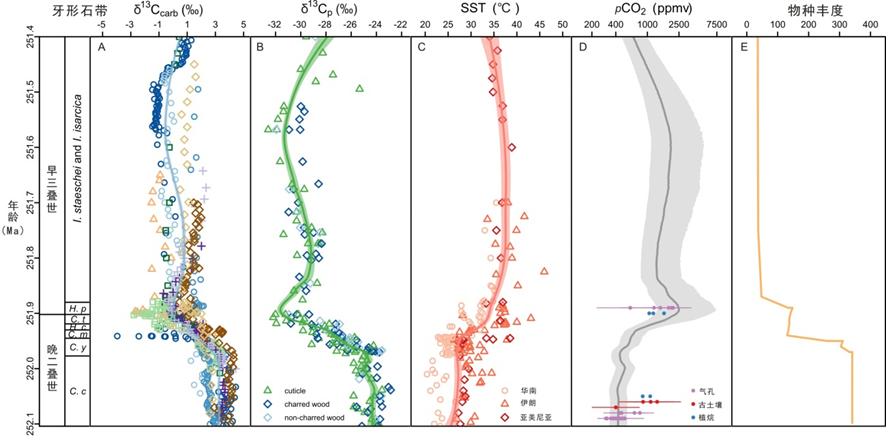Abstract
The Permian–Triassic mass extinction was marked by a massive release of carbon into the ocean-atmosphere system, evidenced by a sharp negative carbon isotope excursion. Large carbon emissions would have increased atmospheric pCO2 and caused global warming. However, the magnitude of pCO2 changes during the PTME has not yet been estimated. Here, we present a continuous pCO2 record across the PTME reconstructed from high-resolution δ13C of C3 plants from southwestern China. We show that pCO2 increased from 426 +133/−96 ppmv in the latest Permian to 2507 +4764/−1193 ppmv at the PTME within about 75 kyr, and that the reconstructed pCO2 significantly correlates with sea surface temperatures. Mass balance modelling suggests that volcanic CO2 is probably not the only trigger of the carbon cycle perturbation, and that large quantities of 13C-depleted carbon emission from organic matter and methane were likely required during complex interactions with the Siberian Traps volcanism.

Fig. : Summary of Permian–Triassic boundary proxy data and reconstructed pCO2 changes.
Wu, Y.Y., Chu, D.L.*, Tong, J., Song, H.J., Dal Corso, J., Wignall, P.B., Song, H.Y., Du, Y. and Cui, Y.*, 2021. Six-fold increase of atmospheric pCO2 during the Permian–Triassic mass extinction. Nature Communications 12: 2137, doi: 10.1038/s41467-021-22298-7
Chu, D.L.*, Dal Corso, J., Shu, W.C., Song, H.J., Wignall, P.B., Grasby, S.E., van de Schootbrugge, B., Zong, K.Q., Wu, Y.Y. and Tong, J.N., 2021. Metal-induced stress in survivor plants following the end-Permian collapse of land ecosystems. Geology. doi: 10.1130/G48333.1